Manuscript accepted on :
Published online on: 24-12-2015
Plagiarism Check: Yes
Sadeghi Limanjoob Reza1, Farzam Mohsen2, Jamali Houshang3, Syahmard Nahid4, kargar Jahromi Hossein5 and Farzam Mohammad2
1Department of Aquatic Animal Health, Veterinary School, Kazerun Branch, Islamic Azad University, Kazerun, Iran.
2Department of Physiology, Veterinary School, Kazerun Branch, Islamic Azad University, Kazerun, Iran.
3Department of Microbiology, Jahrom Branch, Islamic Azad University, Jahrom, Iran.
4Department of Physiology, Medical School, Kazerun Branch, Islamic Azad University, Kazerun, Iran.
5Zoonoses research center, Jahrom University of Medical Sciences, Jahrom, Iran.
DOI : https://dx.doi.org/10.13005/bpj/497
Abstract
This study aimed to provide the Appropriate Strategy in order to Avoid Economic losses Caused by the ICHthyophthirius Parasite on Ornamental Goldfish Species in the city of Shiraz in the four cardinal directions. In this study Pearl scale, Calico, Black Moor, Red Cap and Lionhead species, were examined and the prevalence of parasites in different conditions such as different temperatures, different turbidity, algal growth, feeding rate and etc. were reviewed. The main result is that management is the most important factor in this disease. The most resistant and most sensitive species are Calico and Pearl scale, respectively. In the absence of management prevalence is associated with increasing temperature and reaches its peak at 27 ° temperature. The proper management reduces the disease at high temperatures. Increased water turbidity, the amount of aeration, algal growth, water replacement rates are very important factors that make fish more susceptible to ICH disease. The results show that water temperature should be high for better and faster treatment of the disease and fish parasites more quickly reach the stage tomite. Goldfish lives at low temperatures, so it is better water temperature gradually raised from fish early life until goldfish reaches maturity to help fish adapt to high temperatures. This not only provides better management of ICH disease but also against other diseases and the disease can be treated quickly.
Keywords
Strategy; Economic loss; ICHthyophthirius Multifilis Parasite; Goldfish ornamental fishes
Download this article as:| Copy the following to cite this article: Reza S. L, Mohsen F, Houshang J, Nahid S, Hossein K. J, Mohammad F. The Study of Appropriate Strategy in Order to Avoid Economic losses Caused by the ICHthyophthirius Parasite on Ornamental Goldfish Species. Biomed Pharmacol J 2014;7(1) |
| Copy the following to cite this URL: Reza S. L, Mohsen F, Houshang J, Nahid S, Hossein K. J, Mohammad F. The Study of Appropriate Strategy in Order to Avoid Economic losses Caused by the ICHthyophthirius Parasite on Ornamental Goldfish Species. Biomed Pharmacol J 2014;7(1). Available from: http://biomedpharmajournal.org/?p=2989 |
Introduction
Disease ICH is of the common diseases of farmed, aquarium and wild fish and caused by a relatively large protozoa called ICHthyophthirius Multifilis. These parasites are easily visible with a microscope of low magnification (1). This parasite is able to tolerate a wide range of temperatures and attacks both species of tropical and cold water fish. This is of protozoan parasites of ciliates. Most ciliates are considered as external parasites. Mature parasites are about 0.5 to 1 mm and are easily visible with a microscope of low magnification. Therefore, the diagnosis is simple and smears the skin and gills of fish are easily recognizable. This parasite is the most common external parasites of freshwater fishes and most dangerous parasites that spend part of their life on the skin, fins and gills (1). This parasite has spread worldwide and has been reported in several species, and resistant to the most common treatments used against other protozoan it is difficult to be eradicated from the infected pond or aquarium. The disease occurs mostly in autumn and winter, probably because of low photosynthetic activity in water (thereby causing oxygen deficiency) and loss of fish immune as the effect of temperature and other factors (1,2).
White spots as sugar granules appear on fish body in ICH disease. Fish with point-like white spots on its body swim at speed and collides its body with bed and inside the aquarium tools, and seem to be bothered. All fishes will be infected with the disease progresses. Parasites penetrate under the fish skin and weaken it, the living conditions become unfavorable for fish, resulting in fish death (3).
goldfish is of Animalia Kingdom, Chordata Phylum, Actinopterygii class, Cypriniformes Order Cyprinidae family, Carassius Genus, c.aurtus Species and c.a.auratus Subspecies. (4). Gold fish scientific name is carassius auratus auratu(4).
Goldfish called the golden fish, red fish, and pond fish. This fish is omnivorous. Its main habitat is usually in Siberia and Southeast Asia it was domesticated a thousand years ago in China. The fish taken and released by humans and so can be seen in Europe’s rivers. The fish arrived in Europe in the 17th century as ornamental fish, and then fish farming have become common in Italy, southern France and Portugal. Furthermore, these fish is spread in Europe wild life. In Iran, the fish can be found in the basin of the Caspian Sea, Uremia Lake, Hamoon, and Karun River (5).
Length of 20 to 25 cm at age of 5 to 6 years for goldfish is ordinary. Samples up to 30 cm and 5/4 kg were observed. A lifespan of 10 to 20 years is not uncommon. Lifetime of 40 years for catfish has been recorded (6).
Goldfish can be classified according to six criteria that include
head profile
eyes shape
Body shape
Scales type
dorsal fin Type
caudal fin type
One of the most suitable methods for the identification and classification of goldfish is based on the fin shape and type of goldfish especially caudal fin. The most important types are classified as:
single-tail goldfish
simple two-tail goldfish
two-tail goldfish with dorsal fin
two-tail goldfish without dorsal fin (7)
Undoubtedly, ornamental fish importance is in their economic and aesthetic values, and today many diseases perish them. With the spread of viral, parasitic, bacterial and fungal organism’s diseases mortality of this species increased and probably some rare fish species are facing extinction. Goldfish lives in freshwater, and so they are seen in many aquarium houses and are occasionally suffer from various diseases. All of this is aimed to seek a solution to avoid the risk of ICH losses in goldfish.
Methods
We need to start by looking for ICH in ornamental goldfish in propagation of ornamental fishes centers of the city, Shiraz. Therefore, we visited goldfish propagation centers in search of ICHthyophthirius Multifilis Parasite, the centers include
Pearls Aquarium, Moshir Crossroads, Bahar Mall Second Floor
Sahel Aquarium, Moshir Crossroads, Bahar Mall Second Floor
Black Aquarium, Moshir Crossroads, Bahar Mall Second Floor
Neon Aquarium, Moshir Crossroads, Bahar Mall Second Floor
Fish World, Gomrok Crossroads
Nemove, Farhang Shahr next to Kosar Pool
World of ornamental fishes, Golestan Town, Allameh Amini Blvd
Fisheries, Eram Blvd
Aquarium, Behind Azadi Park
Sadaf Aquarium, Pasargad Blvd
This study uses five sub-species of goldfish including
Calico goldfish
Pearl scale goldfish
Black Moor goldfish
Red Capgoldfish
Lionhead goldfish
These are available in the market more than other species with a lot of fans. Fishes to be examine should be caught by creel and let to relax, then the whole body of the fish.is examined
It should be noted that out of water fish examination should not exceed 5 minutes to prevent damage to fish from lack of oxygen. [8]
During the examination we found suspicious samples, the samples were sent to faculty department and were anesthetize. To do so, head trauma or drug (MS222) can be used (9). Usually anesthetic drugs are used with the big fish or when a live parasite is needed. Course, it should be noted that this medication can unmoved parasite, or in some cases, the parasite is destroyed.
After leaving the fish on wipes, fins and gills samples were taken and examined under a microscope (9). Samples were prepared by spreading wet slide, the sample was placed on a slide of saline and cover slip put on it.
After preparing the sample, microscope magnification of 4x was used to watch the parasites. Below is a microscope picture of the parasites.
Giemsa stain is used in painting parasites and then watched under a microscope.
Results
Based on the analysis, the incidence of ICH in different goldfish races in the same aquarium condition is different. Accordingly, the most resistant and most sensitive species are Calico and Pearlscale, respectively.
The following diagram shows incidence of ICH in similar aquarium circumstances in goldfish species
Incidence in percent
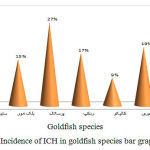 |
Figure 1: Incidence of ICH in goldfish species bar graphs
|
Given that the changes in temperature provides the conditions for the growth of these parasites on the fish’s body, incidence of ICH in different temperatures in goldfish species have been studied. The following graphs show the obtained results:
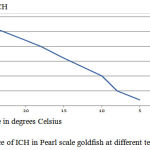 |
Figure 2: Incidence of ICH in Pearl scale goldfish at different temperatures
|
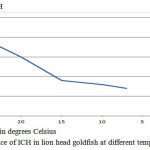 |
Figure 3: Incidence of ICH in lion head goldfish at different temperatures
|
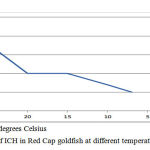 |
Figure 4: Incidence of ICH in Red Cap goldfish at different temperatures
|
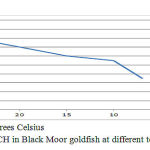 |
Figure 5: Incidence of ICH in Black Moor goldfish at different temperatures
|
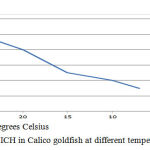 |
Figure 6: Incidence of ICH in Calico goldfish at different temperatures
|
As can be seen in the graph above incidence increases with increasing temperature, but interestingly epidemic is higher at low temperatures.
The reason is that at low-temperature parasitic cyst remains in the body of the fish. At this stage does not respond to treatment, with increasing temperature, the evolution of parasites is faster and reaches the tomite stage and response to treatment at this stage, so this is why the disease is more prevalent in low-temperature but at high temperatures due to the rapid response to treatment is less common. It should be noted that there are differences between the prevalence and incidence of this disease.
In general, the disease is found at low temperatures, but is treated in the high temperatures that is increasing temperature is a major problem for Goldfish. Below is a graph of the prevalence of disease in goldfish species.
 |
Figure 7: spot chart of ICH prevalence rates in different goldfish species
|
The studies show that the turbidity of the water affects the incidence of the disease in different species with almost identical prevalence. The diagram below represents the impact of water turbidity on the disease.
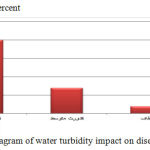 |
Figure 8: bar diagram of water turbidity impact on disease Ike
|
The disease incidence is related to feeding program and was slightly higher in the fish that were feeding two times than those that were feeding at a time. It is conjectured that due to more feedings water turbidity increases and there are more disease prevalence. The influence of these parameters can be seen in the following graph.
 |
Figure 9: bar diagram of water replacement impact on ICH disease rates
|
The sooner the water replaces the incidence is reduced to a certain proportion.
 |
Figure 10: Effect of water replacement frequency on ICH disease incidence
|
Discussion and Conclusions
The study on goldfish fish in the city of Shiraz show this parasite disease prevalence rates were higher than other parasitic diseases. To better control the disease other research results can also be used, the following are a few of the points.
Rahim Peyghan 2001 states that ICHthyophthirius Multifilis is one of the most dangerous freshwater fish disease causes of white spot. This not only causes serious death rates but can cause reduced growth of fish that survived the disease. The parasites are globally spread and all freshwater fish are sensitive to it. ICHthyophthirius Multifilis is the only known species of the genus ICHthyophthirius (9, 10).
Mehdi Arjini in a study 2003 concluded that the time required for the growth of the parasite under the skin depends on two main factors of temperature and fish immune system strength. The stronger and healthier fish, the cells growth will be much slower. In any case, each cell within a wall created around it can create more than 1000 cells within 8 to 24 hours (8).
Mehdi Arjini in another study 2008 suggests that ICH diseases transmitted directly from fish to fish and thus, it can quickly spread in an aquarium with high density. Sick fish collide with aquarium supplies and become frail and weak and are subject to secondary infections or bacterial infections (4).
Meanwhile, New fish arrival into aquarium, live foods or plants are usually associated with white spot disease, so a quarantine period of 2 to 3 weeks of treatment with a specific drug prevention method is good for all new fish (4).
Elainein a book titled “Aquarium” translated by Hossein Fardroo (2007) stated that in this condition, the body and swimming fins of fish are covered with white spots. The disease is spread widely and quickly and better and faster responds to treatment in high temperature water (11).
Hossein Emadi in a book titled “Reproduction of freshwater aquarium fish”, 2011 state that infected with ICH fish is lazy and slow with closed fines. Parasite feed of red blood cells of fish, and with less red blood cells death comes sooner. It is impossible eliminate Parasite to as long as parasites resides on the fish’s body. When the water temperature rises, the parasites leaves fish body for reproduction and then fish easily respond to treatment (12).
The studies concluded that goldfish affection rates depend on the aquarium management and in the case of poor management the incident is very fast, and will bring great losses. Moreover, the prevalence of the disease also exacerbates secondary incidents.
Although the prevalence of the disease in various goldfish species is slightly different and some are more resistant species such as Calico but other factors such as oxygen levels, water turbidity, feeding rate and food type is very influential in the spread of disease.
The life cycle of this parasite involves parasites trophont in the fish body, whICH contains many cysts and finally is released. The infection is in tomite stage respond to treatment and in low temperature evolution is later completed a course of treatment will be very long. Since goldfish lives at low temperatures, so response to treatment is very difficult. The sudden raised water temperature in the goldfish ICH treatment can cause fish deaths. The main reason is the reduction of dissolved oxygen in the water.
Generally, goldfish is more resistant than many other ornamental fish and only with respect to management issues and a thorough understanding of suitable life and environmental conditions for aquatic life their life span can be longer and safer.
Conclusions
In this study, the results were classified as follows
For better and faster treatment the water temperature should be high up to faster parasite reaches the tomite stage. Goldfish lives at low temperatures, so it is better to raise the water temperature gradually from goldfish fish early life until adulthood so that fish are adapted to high temperatures. This manages the fish in not only facing with the ICH disease but also against other diseases and if the disease observed can be treated quickly.
If the temperature increases the oxygen level should be considered, since temperature increase greatly reduces dissolved oxygen and goldfish are very sensitive to oxygen and oxygen supply and it is better to provide them with oxygen in 24 hrs.
The daily excretion rate of goldfish is more than many other ornamental fishes. This in turn affects the amount of water turbidity, algal growth, water oxygen content, water temperature, water pH, and many other factors causing predispose ICH fast growing environment for parasites and so in disease prevention two important factors should be considered.
Feeding rate
should be lower than other aquarium fish and once a day is recommended.
Water replacement rate
this depends on the concentration; with the higher concentration water should be replaced faster. The fish body strengthens using multivitamins on the market significantly reduced the incidence.
References
- Abdi, MohammadKazem., (1384): A Practical Guide forVeterinaryParasitology
- Emadi, H.., (1360): freshwater fish, Fish Technical Institute, Tehran, pp. 22-210 and 298-290.
- Eslami, Ali., (1368): Cream of Veterinary Medicine, Tehran University Press
- Arjini, Mehdi., (1387): GoldfishGuide, Second Edition
- Sheikhian, Mohammad Reza., (1386): Goldfish(Golden Fish), Tehran
- Mojetta, Angelo. (1995): THE AQUARIUM A COPLETE GUIDE. Blandford.165 p.
- Mild, Disk. (1997): YOU & YOUR AQUARIUM. Dorling Kinderseley .PP: 211-235.
- Arjini, Mehdi. (1382): Health and diseases of Aquarium Fish, pp. 20-18.
- Peyghan,Rahim., (1380): Parasitesandparasitic diseasesof fish, p
- PeyghanRahim., (1373) IchthyophthiriusDiseaseinFishJournal ofFisheriesof Iran, 2, YearIII, pp.24-17.
- Elaine., (1386): Aquarium, translated by HosseinFar Pour.
- Emadi, H., (1360): fish, freshwater fish andTechnical Institute, Tehran, 22-210and298-290.







